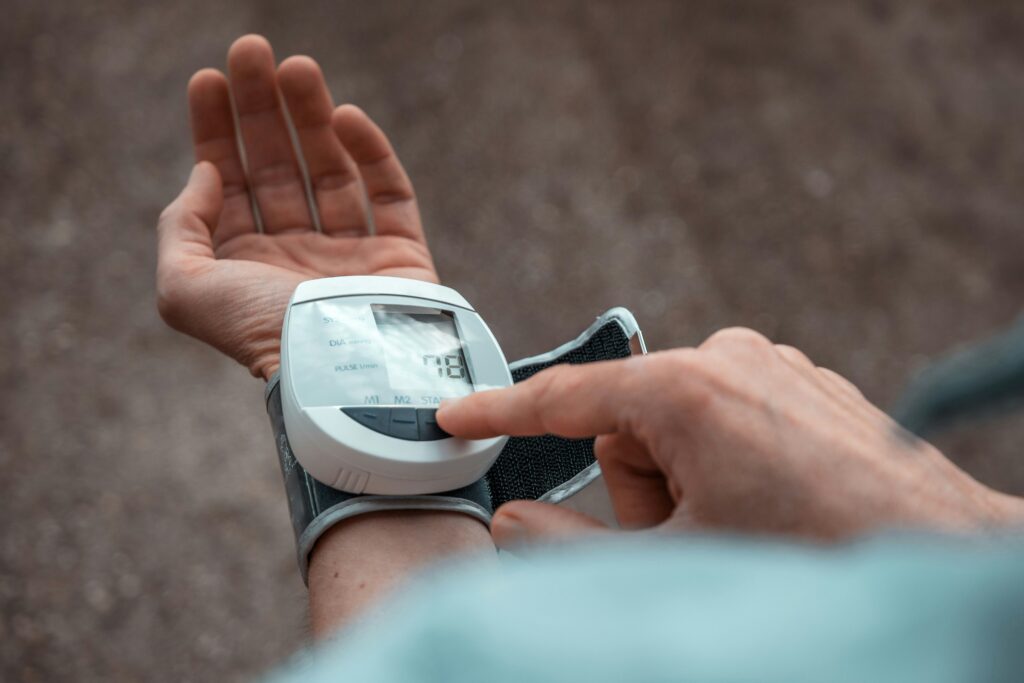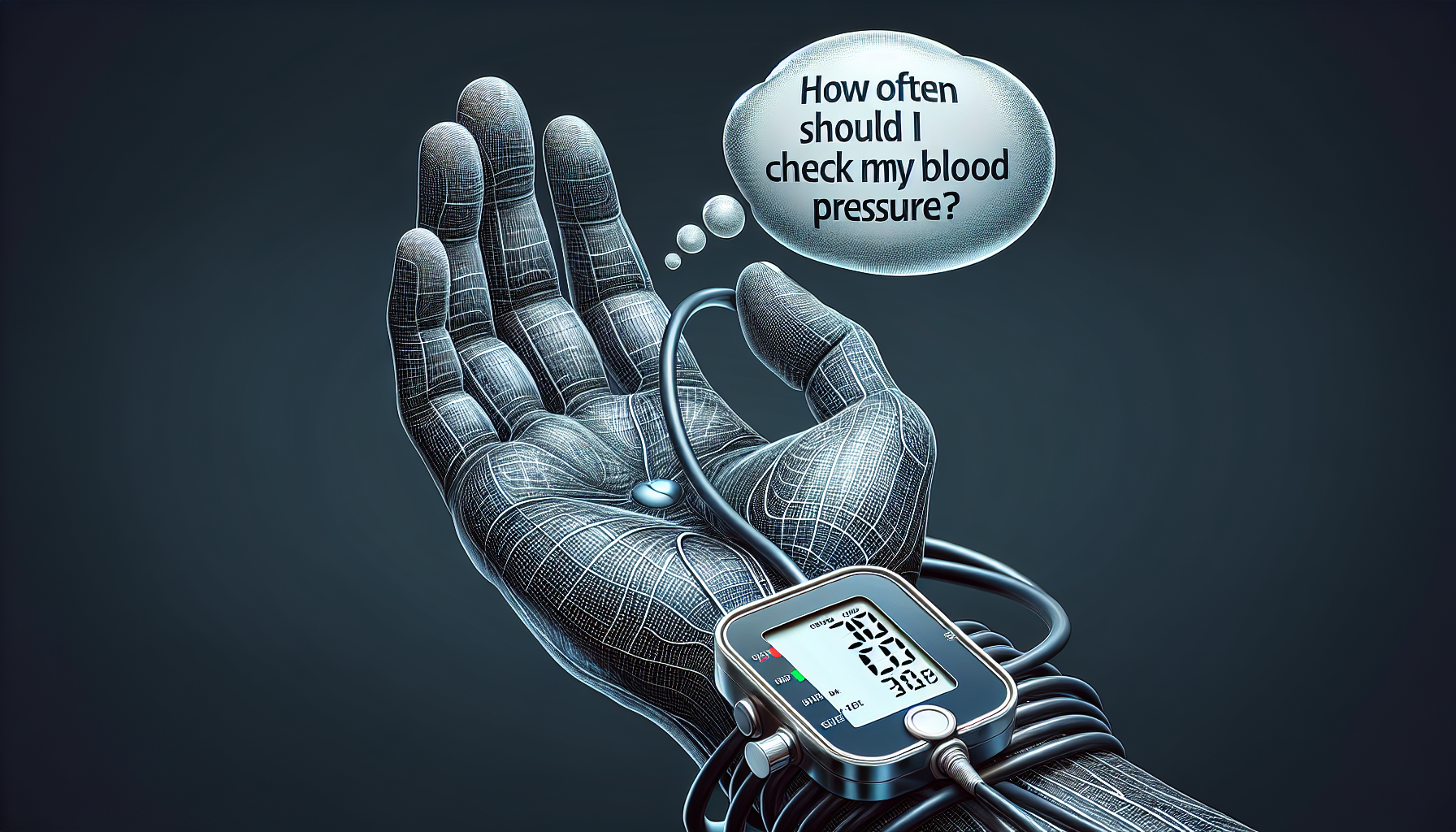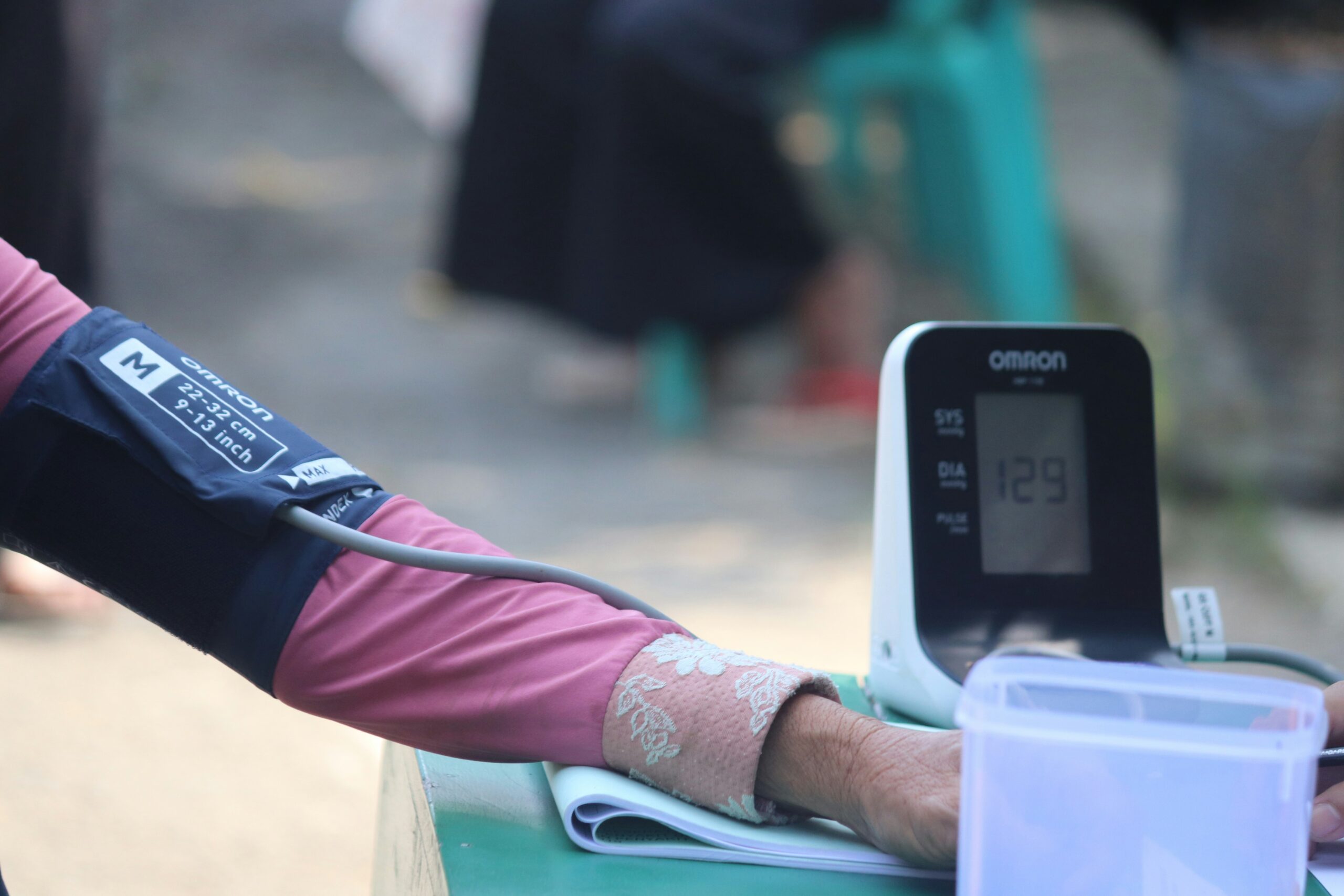Are you wondering how often you should check your blood pressure? It’s an important question, as maintaining healthy blood pressure levels is crucial for overall well-being. Recent scientific studies have shed light on this topic, providing valuable insights. One study published in the Journal of the American Medical Association (JAMA) found that checking blood pressure at home twice a day led to better control of hypertension. Another study in the European Heart Journal suggested that measuring blood pressure at least once a month could help detect potential cardiovascular issues early on. These studies emphasize the significance of monitoring your blood pressure regularly to ensure optimal health.

Discover the Ultimate Weight Loss Secrets Here!
Factors influencing blood pressure
Diet and lifestyle
Your diet and lifestyle choices can have a significant impact on your blood pressure. Consuming a diet that is high in salt, saturated fats, and cholesterol can contribute to higher blood pressure levels. On the other hand, following a healthy diet that is low in sodium, saturated fats, and cholesterol, such as the DASH (Dietary Approaches to Stop Hypertension) diet, can help maintain normal blood pressure. Additionally, maintaining a healthy weight, engaging in regular exercise, and managing stress are all important lifestyle factors that can influence your blood pressure levels positively.
Age and gender
Blood pressure tends to increase with age. As you get older, your blood vessels become less elastic and more rigid, making it harder for blood to flow through them. This can lead to higher blood pressure levels. Furthermore, men tend to have higher blood pressure compared to women until women reach menopause. After menopause, women’s blood pressure levels increase and become similar to men’s.
Family history
If you have a family history of high blood pressure or cardiovascular diseases, you may be at a higher risk of developing high blood pressure yourself. Genetic factors can play a role in blood pressure regulation, so it is essential to be aware of your family’s medical history.
Medical conditions
Certain medical conditions can contribute to high blood pressure. These include kidney disease, diabetes, hormonal disorders (such as Cushing’s syndrome or thyroid disorders), and sleep apnea. If you have any of these conditions, it is crucial to monitor your blood pressure regularly and work closely with your healthcare provider to manage and control your blood pressure effectively.
General guidelines for blood pressure checks
American Heart Association recommendations
The American Heart Association (AHA) recommends that adults have their blood pressure checked at least once every two years if their blood pressure is consistently below 120/80 mm Hg. For individuals with blood pressure readings of 120-139/80-89 mm Hg, the AHA suggests more frequent blood pressure checks, such as every year. If your blood pressure is consistently 140/90 mm Hg or higher, the AHA advises seeking medical advice and more frequent blood pressure monitoring.
National Institute for Health and Care Excellence guidelines
The National Institute for Health and Care Excellence (NICE) in the UK recommends that individuals have their blood pressure checked annually if it is consistently below 130/80 mm Hg. Individuals with blood pressure readings of 130-139/80-89 mm Hg are advised to have it checked every three to six months. For individuals with blood pressure consistently at 140/90 mm Hg or higher, more frequent monitoring and medical evaluation are recommended.
World Health Organization guidelines
The World Health Organization (WHO) suggests that blood pressure should be checked at least once every two years for adults aged 18 years and older. However, individuals with known risk factors or those who have had previous high blood pressure readings may require more regular blood pressure checks as recommended by their healthcare provider.
Click Here for Proven Fat-Burning Strategies!
Normal blood pressure ranges
Systolic and diastolic measurements
Blood pressure is measured using two numbers: systolic and diastolic. The systolic pressure (the top number) represents the pressure in the arteries when the heartbeats, while the diastolic pressure (the bottom number) represents the pressure in the arteries when the heart is at rest between beats. A healthy blood pressure reading is typically below 120/80 mm Hg.
Understanding blood pressure numbers
Blood pressure numbers can sometimes be confusing, but understanding what they mean is essential. Normal blood pressure falls within the range of 90-120 mm Hg for systolic pressure and 60-80 mm Hg for diastolic pressure. Higher readings may indicate prehypertension or hypertension, and lower readings may suggest hypotension. It is essential to know your blood pressure numbers and what they mean to assess your cardiovascular health accurately.
Optimal blood pressure ranges
While there is no specific blood pressure range considered “optimal,” it is generally agreed that maintaining a blood pressure reading below 120/80 mm Hg is ideal for most individuals. However, the recommended target blood pressure may vary depending on factors such as age, underlying medical conditions, and overall health. It is essential to consult with your healthcare provider to determine your personal optimal blood pressure range.
Self-monitoring blood pressure
Benefits of self-monitoring
Regular self-monitoring of blood pressure can provide valuable information about your cardiovascular health and help you take control of your blood pressure management. By monitoring your blood pressure at home, you can detect any fluctuations or trends over time. This information can assist you and your healthcare provider in making informed decisions regarding lifestyle modifications, medication adjustments, and overall blood pressure management.
Choosing a reliable blood pressure monitor
When selecting a blood pressure monitor for home use, it is important to choose a reliable and accurate device. Opt for a monitor that has been validated by regulatory authorities, such as the British Hypertension Society or the Association for the Advancement of Medical Instrumentation. Choose a monitor that fits properly on your upper arm or wrist and consider additional features, such as digital displays, memory storage, and ease of use.
Proper technique for self-measurements
To ensure accurate blood pressure readings, it is essential to follow proper technique during self-measurements. Sit in a quiet and comfortable environment, with your feet flat on the floor and your back supported. Rest for at least five minutes before taking the measurement. Position the cuff according to the manufacturer’s instructions, ensuring a snug and proper fit. Relax your arm, keep it supported, and avoid talking or moving during the measurement. Take multiple readings at different times of the day and record the results to identify patterns and trends accurately.

Frequency of blood pressure checks
Healthy individuals with normal blood pressure
Healthy individuals with consistently normal blood pressure readings below 120/80 mm Hg should have their blood pressure checked at least every two years, as recommended by the AHA. Regular monitoring can help detect any changes or trends over time and serve as a baseline for comparison in the future.
Individuals with hypertension
If you have been diagnosed with hypertension, it is crucial to monitor your blood pressure more frequently. The frequency of checks may depend on the severity of your condition, your response to treatment, and any additional risk factors you may have. Your healthcare provider will determine the appropriate monitoring schedule, but it is not uncommon to have your blood pressure checked every few weeks to months initially and then at regular intervals once it is well-controlled.
Individuals with high-risk conditions
Individuals with high-risk conditions, such as diabetes or kidney disease, are at greater risk for developing high blood pressure or cardiovascular complications. Regular blood pressure checks are highly recommended for these individuals to detect any changes early on, enable prompt intervention, and manage their conditions effectively.
Pregnant women
During pregnancy, blood pressure can fluctuate, and conditions such as preeclampsia can arise. As a result, pregnant women should have their blood pressure monitored regularly throughout their pregnancy as part of routine prenatal care. Your healthcare provider will determine the appropriate monitoring schedule based on your individual needs and any specific risk factors you may have.
Children and adolescents
While high blood pressure is less common in children and adolescents, it can still occur, especially in those who are overweight or have a family history of hypertension. Regular blood pressure checks are recommended during routine well-child visits to identify any potential issues early on and promote healthy cardiovascular development.
Target blood pressure for different populations
Adults over 60 years
For adults over the age of 60, a blood pressure reading below 150/90 mm Hg is generally accepted as a target. However, individualized targets may be set by your healthcare provider based on your overall health, any underlying medical conditions, and your response to treatment.
Adults under 60 years
Adults under the age of 60 are generally recommended to maintain a blood pressure reading below 140/90 mm Hg. However, personalized targets may be set depending on individual factors and overall cardiovascular risk.
Pregnant women
During pregnancy, blood pressure targets may differ from those in non-pregnant individuals. The American College of Obstetricians and Gynecologists recommends a blood pressure reading below 140/90 mm Hg for pregnant women, but optimal targets should be discussed with your healthcare provider based on your specific circumstances.
Children and adolescents
Blood pressure targets for children and adolescents depend on their age, gender, and height. The American Academy of Pediatrics provides age-specific blood pressure percentiles to determine whether a child or adolescent falls within a healthy blood pressure range. Your child’s pediatrician can assess their blood pressure readings and determine appropriate targets based on these percentiles.

Monitoring blood pressure at home
Importance of regular monitoring
Regular monitoring of blood pressure at home is essential for individuals with hypertension or those at risk of developing high blood pressure. Home monitoring helps provide a more comprehensive picture of your blood pressure trends, as it eliminates the potential “white coat effect,” where blood pressure tends to be elevated in a healthcare setting due to anxiety or stress. By monitoring your blood pressure at home, you can detect any changes early on and work with your healthcare provider to manage your blood pressure effectively.
Tips for accurate readings
To ensure accurate blood pressure readings at home, it is important to follow a few tips. Make sure you are using a properly calibrated and validated blood pressure monitor as discussed earlier. Take measurements at the same time each day, preferably before taking any medications or engaging in any strenuous activities. Avoid smoking, consuming caffeine, or exercising for at least 30 minutes before taking a measurement. Additionally, ensure you are in a quiet and comfortable environment, and follow the proper measurement technique as mentioned earlier.
Recording and tracking results
To monitor your blood pressure effectively, it is important to record and track your results consistently. Keep a log or use a blood pressure tracking app to record your measurements, including the date, time, and any relevant notes such as medication changes or lifestyle modifications. By tracking your results over time, you and your healthcare provider can identify any patterns or trends and make informed decisions regarding blood pressure management strategies.
Consulting a healthcare professional
When to seek medical advice
While self-monitoring your blood pressure at home is beneficial, it is important to seek medical advice if you notice any significant changes or if your blood pressure consistently remains elevated. Contact your healthcare provider if your blood pressure readings are consistently above your target range, if you experience symptoms such as chest pain or dizziness, or if you have any concerns about your cardiovascular health.
Role of healthcare providers
Healthcare providers play a crucial role in monitoring and managing blood pressure. They can help determine your target blood pressure range, assess any existing medical conditions or risk factors, and provide guidance on lifestyle modifications and medication options. Regular follow-up appointments with your healthcare provider are important to evaluate your progress, adjust treatment plans if necessary, and address any concerns or questions you may have.
Follow-up appointments and adjustments
Based on your individual circumstances, your healthcare provider will determine the frequency of follow-up appointments and adjustments to your treatment plan. These appointments may include blood pressure measurements, discussions about lifestyle modifications, medication adjustments, and overall monitoring of your cardiovascular health. By staying engaged with your healthcare provider, you can work together to manage your blood pressure effectively and reduce your risk of complications.

Lifestyle modifications for blood pressure management
Healthy diet and weight management
Adopting a healthy diet, such as the DASH diet, can have a significant impact on blood pressure management. This diet emphasizes fruits, vegetables, whole grains, lean proteins, and low-fat dairy products while reducing sodium intake. Additionally, maintaining a healthy weight through portion control, regular physical activity, and mindful eating can help lower and manage blood pressure levels.
Regular exercise and physical activity
Engaging in regular physical activity and exercise is beneficial for blood pressure management. Aim for at least 150 minutes of moderate-intensity aerobic activity or 75 minutes of vigorous-intensity aerobic activity per week, along with muscle-strengthening activities twice a week. Regular exercise helps lower blood pressure, improve cardiovascular health, and contribute to overall well-being.
Reducing stress and relaxation techniques
Chronic stress and high levels of anxiety can contribute to elevated blood pressure. Implementing stress-reducing techniques, such as deep breathing exercises, meditation, yoga, or engaging in hobbies and activities that you enjoy, can help manage stress levels and promote better blood pressure control.
Limiting alcohol and quitting smoking
Excessive alcohol consumption can raise blood pressure and increase the risk of cardiovascular diseases. It is recommended to limit alcohol intake to moderate levels, which means up to one drink per day for women and up to two drinks per day for men. Smoking also significantly increases the risk of hypertension and cardiovascular diseases. Quitting smoking is a crucial step in blood pressure management and overall cardiovascular health.
Managing chronic conditions
If you have underlying medical conditions such as diabetes or kidney disease, it is essential to manage and control these conditions properly. Effective management of chronic conditions can contribute to better blood pressure control and reduce the risk of complications.
Medication adherence
In some cases, lifestyle modifications alone may not be sufficient to control blood pressure, and medication may be required. If prescribed medication, it is crucial to take it as directed by your healthcare provider. Adhering to your medication regimen can help maintain consistent blood pressure levels and improve overall cardiovascular health.
Conclusion
Regular blood pressure monitoring is an important aspect of maintaining overall cardiovascular health. Factors such as diet and lifestyle, age and gender, family history, and medical conditions can all influence blood pressure levels. Following general guidelines for blood pressure checks, understanding normal blood pressure ranges, and self-monitoring blood pressure can help individuals effectively manage their blood pressure and make informed decisions about lifestyle modifications and treatment options. Maintaining a healthy lifestyle, consulting with healthcare professionals, and adhering to medication regimens, when necessary, can play a key role in blood pressure management and reduce the risk of cardiovascular complications. By being proactive in monitoring and managing your blood pressure, you are taking an active step towards a healthier future.

